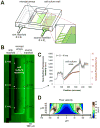A neuron-benign microfluidic gradient generator for studying the response of mammalian neurons towards axon guidance factors
- PMID: 20957287
- PMCID: PMC3786697
- DOI: 10.1039/c0ib00038h
A neuron-benign microfluidic gradient generator for studying the response of mammalian neurons towards axon guidance factors
Abstract
Investigation of biochemical cues in isolation or in combinations in cell culture systems is crucial for unraveling the mechanisms that govern neural development and repair. The most widely used experimental paradigms that elicit axon guidance in vitro utilize as the source of the gradient a pulsatile pipette, transfected cells, or a loaded gel, producing time-varying gradients of poor reproducibility which are not well suited for studying slow-growing mammalian cells. Although microfluidic device design have allowed for generating stable, complex gradients of diffusible molecules, the flow-induced shear forces in a microchannel has made it impossible to maintain viable mammalian neuronal cultures for sufficiently long times. In this paper, we describe axonal responses of mouse cortical neurons in a "neuron-benign" gradient-generator device based on an open chamber that can establish highly stable gradients of diffusible molecules for at least 6 h with negligible shear stress, and also allows the neurons to thrive for at least 2 weeks. Except for the period when the gradient is on, the cells in the gradient are under the same conditions as the cells on the control surfaces, which ensure a consistent set of micro-environmental variables. The gradient stability and uniformity over the cell culture surface achieved by the device, together with our software platform for acquiring, post-processing and quantitatively analyzing the large number of images allowed us to extract valuable information even from small datasets. We report a directed response of primary mammalian neurons (from E14 embryonic mice cortex) to a diffusible gradient of netrin in vitro. We infer from our studies that a large majority (∼73%) of the neurons that extend axons during the gradient application grow towards the netrin source, and our data analysis also indicates that netrin acts as a growth factor for this same population of neurons.
Figures






References
-
- Chilton JK. Developmental Biology. 2006;292:13–24. - PubMed
-
- Song HJ, Poo MM. Nature Cell Biology. 2001;3:E81–E88. - PubMed
-
- TessierLavigne M, Goodman CS. Science. 1996;274:1123–1133. - PubMed
-
- Ranscht B. International Journal of Developmental Neuroscience. 2000;18:643–651. - PubMed
-
- Skaper SD, Moore SE, Walsh FS. Progress in Neurobiology. 2001;65:593–608. - PubMed
MeSH terms
Substances
Grants and funding
LinkOut - more resources
Full Text Sources
Other Literature Sources

